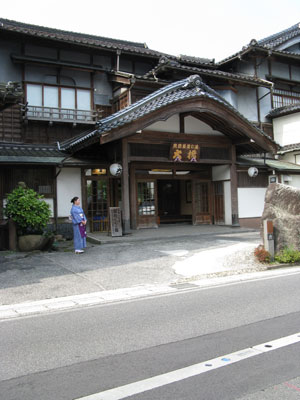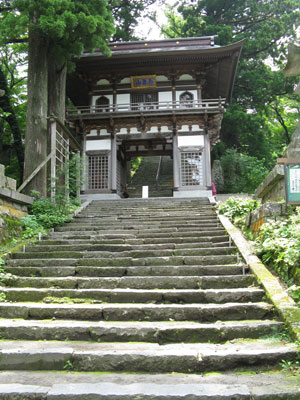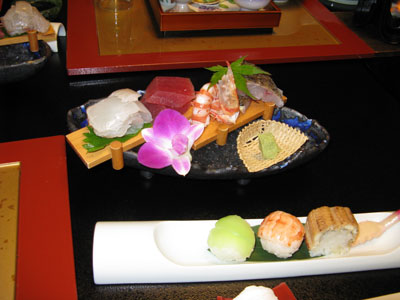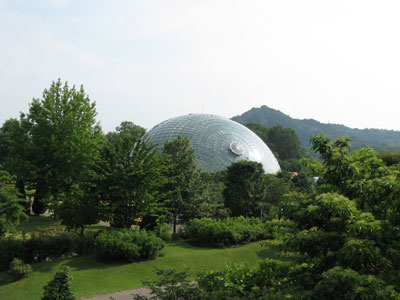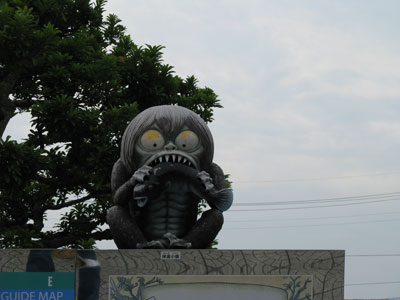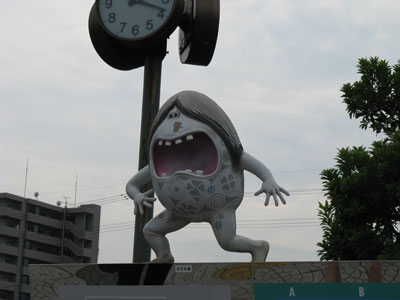Japan — Touring Tottori
by Mary Beltran, Assistant Editor, ITN
During my first visit to Japan, in 2009, I hit a few of the typical first-time-in-Japan sightseeing highlights: busy cities, fabulous shopping, “tea and temples” and ancient castles. When I was offered an opportunity to return in July ’11, I hoped to focus on some of my personal interests: birding, gardens, history, art and, of course, savoring the local food. The compact Tottori Prefecture seemed like the perfect place to pack all of that into a relatively brief eight-day trip.
Tottori is located on the western coast of Japan’s main island of Honshu, within easy travel distance of Tokyo and Osaka. My trip took me from east to west across Tottori, beginning in Tottori City and continuing to the coast, then inland through Kurayoshi City, in the middle of the prefecture, to the forests and mountains of Misasa Town, up to Mt. Daisen and, finally, to Yonago.
Tokyo
On the flight from San Francisco on Japan Airlines (800/525-3663), I sat in Economy Plus, which provided extra legroom, a slightly wider seat and a large armrest.
When we landed in Tokyo Haneda airport at 10 p.m., I transferred directly to the Haneda Excel Hotel Tokyu (phone +81 3 5756 6000), conveniently located at the end of the domestic airport terminal. This Western-style hotel had all the amenities. My room (¥28,000, or $362, double) was clean and quiet, and the included breakfast buffet was great.
In Tokyo, I saw no signs of damage from the March ’11 earthquake that devastated the northeastern portion of Honshu. I was told that any damage had been cleared and repairs, done.
Although some people think that all of Japan was damaged in the quake, that is simply not so. Japan is an archipelago of more than 6,000 islands, and Honshu is 807 miles long. (In comparison, my home state of California is 770 miles long.) Tokyo is 150 miles away from the quake’s epicenter.
It is also well away from the radiation zone around the damaged nuclear power plants in Fukushima and Onagawa. I was told that the background level of radiation in Tokyo is back to its normal level. Tottori is farther from the power plants and its levels are even lower.
For travelers, the one inconvenience that I noticed was very little air-conditioning being used in public buildings because the country is conserving energy. The airports and metro stations were extremely warm and humid.
However, while there was little physical damage from the earthquake to be seen in Tokyo, I did feel the quiet sadness of the country over the terrible losses so many have suffered.
On to Tottori
The morning after my arrival, I took a one-hour flight on All Nippon Airways (800/235-9262) to Tottori City and was met by Akiko Tanabe and Lisa Fang (our interpreter) of Tottori’s tourism office, who were with me for my whole stay. Akiko had arranged an itinerary that included every item I was interested in as well as a few surprises that I might never have found on my own.
After dining in Hotel New Otani’s excellent top-floor Grill Belle Vue restaurant (phone +0857 23 1111), offering lunches for ¥1,000-¥4,000 and a great view over Tottori city, we headed to the Uradome Coast Geological Park. The park extends along a section of coastline where spectacular upthrusts of granite have been slowly eroded by the waves to form a crumbling chaos of small islands, narrow inlets and dark caves with cool, clear pools.
At a little marina, we piled into an open-sided boat and motored out to see the rocky coast. San’in Matsushima Yourun Company (Iwami-gun; phone 0857 73 1212, e-mail info@yourun1000.com) runs regular trips on large, enclosed sightseeing boats that travel up and back for a quick half-hour tour (¥1,200 per adult), but their smaller, 12-person boat, which we took (¥2,100 per adult on regularly scheduled cruises or ¥20,000 chartered), could weave in and out along the rocky shore.
The water in the coves and between the rocks was quite calm, and the scenery was spectacular! As we puttered in and out of channels between the huge, rocky islands and into some of the larger sea caves, I saw cormorants, sea ducks, gulls and a great grey heron.
After the boat tour, we drove the scenic road along the bluffs where there is public beach access from a parking lot on the road, the beach reachable via steep but well-made trails.
One note about the weather — in the beginning of July, the southwest part of Honshu is hot, rainy and very humid. The weather during my stay ranged from sunny, muggy and hot to cloudy, cool and raining. Toward the end of July, it usually begins to clear. In the fall, it is clear but cool, and winters are cold and snowy.
Ryokan stay
That evening I had my first experience staying in a ryokan, a uniquely Japanese inn. The three ryokan in which we stayed on this trip were built in the classic Japanese style and the interiors were beautifully decorated.
In the town of Iwami, we were greeted at the Iwaiya Ryokan (544 Iwai, Iwami-cho, Iwami-gun) by a kimono-clad hostess who showed us the special yukata (cotton kimono-style robes) and slipper socks we were to wear during our stay.
We had a fit of giggles as the poor lady kept pulling out yukatas for me — first a small size, for ladies of petite stature (no way!); medium size, normally for men (nope!), and extra-tall/large size (well, almost). I’m 5'10" and not petite, so we never did find one that really worked.
Dinner was fabulous, and it was my first inkling of what I could look forward to for the next few nights. At each of the three ryokan, the meals, one of the main pleasures of these destination inns, were impressive. They were so gorgeous that we all got out our cameras, but my food photography suffered because my appetite interfered.
Though the individual portions were not very large, there were many courses; they just kept coming and coming! I was always stuffed to the gills, but it was delicious.
My room at Iwaiya was large and simply furnished with a low table and a few cushions to sit on. At night, the table was moved to the side and a futon was unrolled for sleeping. The room had all the standard hotel amenities: flat-screen TV, coffee maker, phone, clock, etc. Behind sliding screens there was another sitting area with a view.
All the ryokan in which we stayed were built over natural hot springs and had special onsen (hot spring baths) with outdoor garden areas in which to soak. The gardens were behind tall fencing for privacy. What a great way to relax and clean up after a day of travel!
Room rates at Iwaiya Ryokan, including breakfast and dinner, range from ¥15,000 to ¥25,000 ($194-$324), depending on the type of evening meal chosen. Dinner for nonguests costs ¥6,000-¥15,000. (Prices are slightly higher in the peak season.)
After dinner we took a drive along the coast, stopping to look at the ocean spangled with brilliant lights. The fishing boats use huge lamps to attract squid, and the fiercely burning lights looked like jewels against black velvet.
Sand dunes
In the morning, we visited the Tottori Sand Dunes. These huge dunes were what first drew my attention to Tottori. The pictures of them reminded me of those rolling, monster dunes in Namibia. I was amazed; I never knew there was anything like that in Japan.
Part of the San’in Kaigan Geopark, which is a member of the Global Geoparks Network, the dunes stretch for nearly 10 miles along the coast. The highest dune is about 295 feet tall.
No camping or sunbathing is allowed on the main dunes, so the area was very clean and the views were unobstructed. The well-organized visitor center has an air-conditioned natural history exhibition building and, outside that, a long bench with foot-washing stations; a shady area; a small snack shop; vending machines; restrooms, and a large parking area.
To get to the dunes, we climbed a long flight of steps up a steep slope (there is also a long ramp for those with difficulty climbing), stopping at the small concrete pad at the top to look out over the wide stretch of sand leading to the dunes. The enormity of the dunes was hard to perceive until I saw how tiny the people looked on the dunes and silhouetted at the top.
Because the surface and shape of the dunes change each night, I think the best time to visit is in the morning, before hundreds of people have marched up and down, leaving their trails behind. The morning air is cooler, as is the sand. At midday it can get burning hot out there, and on sunny days in the summer there is a lifeguard stationed to rescue people — not from the nearby ocean but from heat exhaustion.
Extraordinary experiences
Next we drove inland into the forests and mountains of the Misasa area and up to Mt. Mitoku, where we were to visit Mitoku-san Sanbutsu-ji Temple complex and one of its unusual temples, the Nageire-do (Thrown-In Temple). This ancient temple is located near the top of Mt. Mitoku and is extremely hard to get to.
Cantilevered into a niche on the north face of the mountain, the temple leaves modern architects baffled as to how it was built. Legend says that a powerful monk lifted the temple and threw it into the niche.
The access trail takes visitors over rough paths and, finally, up a steep, rocky screed, climbable only with the help of a metal chain to pull against. Some do make the climb to the top, but we made it only up to the first buildings of the temple complex, where the head monk explained its history and walked us through a small museum with artifacts from the temple. While we were there it began to pour rain, so we were relieved of the obligation to climb any higher.
Ryokan Ohashi (phone +81 0858 43 0211) in Misasa was a treat that night. Built in the middle of a river over two hot springs, the very old and beautifully maintained building has all the modern conveniences inside. The onsen were exquisite, and since my bathroom also used the hot spring water, I had a toasty shower.
My room (¥23,000, including dinner) was very large, with a long bank of windows that brought in lots of light and offered a view of the river.
There we were treated to a special meal made by the ryokan’s award-winning chef — a true gourmet experience with exquisite presentations, elaborate displays and delicious dishes.
For example, our 10 appetizers included a “cherry” made of cream cheese wrapped in pink strips of shrimp sashimi with a pine needle for a stem; tiny “frogs” carved from cucumber slices, and a jewel-like “hydrangea” of purple gelatin with gold sprinkles.
The chef cooked some of his specialties right in front of us on a brazier in the dining area. It was a meal to remember.
Mt. Daisen
The next day we went on to the Yonago area and the pine forests of Daisen-oki National Park. In the summer, hundreds of people visit to walk the forest paths, see area temples or hike the mountain trails, some climbing to the Mt. Daisen summit (5,600 feet) to watch the sunrise or sunset.
The weather can change rapidly on the mountain, so hikers must be prepared for cold temperatures and rain even when it’s sunny and hot below.
The park’s information center is in the small town of Daisen-cho, a popular base for skiing in the winter. I was told that a shuttle bus runs around Mt. Daisen, stopping at several trailheads and the main temple access points. The trails leading to the main temples on the mountain are well marked; maps labeled in English are available at the information center (Daisen 40-33), located just across the street from the Daisen Natural History Museum (phone +0859 52 2327).
The museum has a good bird exhibit and sometimes arranges birding or nature walks. (You’ll need to check ahead; they are not available every day.)
Daisen National Park is open 24/7 and admission is free. Some camping is allowed.
Our lunch that day was in the Buddhist vegetarian style at Sanrakuso (Daisen 14), near the temple complex. Many of the ingredients came from the mountain, including specialties like fiddle fern fronds and lotus root. The food was excellent (¥2,000, or $26) and a nice change from all the seafood we’d been enjoying.
Garden blooms
Tottori Hanakairo Flower Park (phone +0859 48 3030, [website in Japanese only]), with an admission fee of ¥700, adult, was next on the schedule. More of a flower theme park than a botanical garden, it features huge displays of flowers, some in rotating exhibits of potted plants but most as mass plantings out in the gardens.
The plantings are designed so there is always something blooming throughout the year. When I was there, the Asiatic lilies were just finishing their bloom, their perfume in the air all around the park.
The garden is divided into four quadrants: a formal rose garden; a water-and-fountain garden; a woodland strolling path with a stream, and the landscape garden with masses of flowers planted in huge beds. In the center of the park is a huge, domed conservatory with a permanent orchid collection. A broad promenade runs dramatically across the gardens from the main gate to the center dome.
A short visit to cover most of the park takes about two hours, but avid gardeners probably will linger for hours and some people spend the whole day.
Because the park is extremely popular with families and retirees, it is fully accessible, with ramps, elevators and long paved pathways. There is even a raised, shaded walkway circling above the whole park. I recommend taking the time to walk around on it; the experience of the garden is quite different from this treetop perspective.
In the evening I was able to go back to see the light show at the park (it’s not open every night, so check the schedule). Special lighting was designed to highlight the fountains, buildings and plants. Beautiful!
We spent the night at the Daisen Royal Hotel (phone/fax +0859 68 2333), a large, Western-style hotel popular with tour groups. The rooms (¥21,000 for a double) were simple, clean and comfortable, with, best of all, really powerful air-conditioning.
Fowl play
I enjoy birding, so I was interested in the Yonago Mizutori Park (Waterfowl Park), located in a wetland conservation area. The wetland, near many rice fields, is bordered on one side by a freshwater lake and on another by the sea.
The two-story visitor center, built at the edge of the 70-acre park, had a terrific bird-watching area with spotting scopes and chairs along three long, windowed sides of the lower floor. Even in the snowy winter you can take the time to really view the birds and still stay warm.
Later in the year, about a thousand tundra swans and 7,500 geese and ducks migrate from Russia to overwinter near the harvested rice fields, fattening up before leaving in the spring. But in early July there were still plenty of year-round residents.
During the hour I was there, I saw nesting grebes, two varieties of duck, a Japanese pheasant and a few egrets, and I heard (but couldn’t spot) a warbler. The center’s nature guide said that about 40% of Japan’s bird species can be seen around the wetlands over the year.
The building (closed Tuesdays) is fully accessible for wheelchairs, and there are several exhibits about the surrounding ecosystem. The admission fee is ¥300 for adults (over 70, free), and the scopes, bird books and other equipment are free to use.
From the bird center, we headed to the Mizuki Shigeru road in Sakaiminato. Shigeru is a famous manga (Japanese-style comics) artist. His work is strange and slightly creepy because it deals with weird, supernatural beings, called Yōkai.
As a tribute to the artist, the town of Sakaiminato, his birthplace, installed more than 100 bronze statues of his characters along a main street. This is an enormously popular place on the weekends, with hundreds of visitors enjoying the sculptures and shopping at the dozens of souvenir shops.
On the water
Even though it was getting cloudy, we decided to go ahead and try our last scheduled activity, sea kayaking (¥3,000 per hour or ¥13,500 for one day).
After our guide from Kaike Tour Desk (13-1-1 Kaike Onsen, Yonago; phone +0859 35 6785) coached us on paddling technique, we were free to scoot around. The plastic, sit-on-top kayaks seemed very hard to tip over, unlike the more professional ones that some people have trouble with.
A breakwater kept the sea behind it very calm, and my kayak floated in easily. The water was only about three to five feet deep, and I paddled around until the guide felt confident I knew what I was doing. Then he led me into deeper water where the waves weren’t very big (no whitecaps, just swells). I had a blast! It was so refreshing to be in the cool water and feel the sea breeze.
After about an hour we returned to shore and squished up to our cars. Yes, we did get wet and sandy, but it was worth it!
That evening we stayed at Yukibou Hakusen (Yonago-shi; phone +0859 33 8900), which was larger than the other two ryokan and had an elevator. Dinner that evening was course after course of fabulous food, including a delicious, cook-your-own broth with small dumplings and vegetables which we each prepared on individual burners right at the table. It’s always fun to play with your food!
The next morning I bid farewell to my hosts and headed to the airport for my flight back to Tokyo.
Back to Tokyo
My trip ended with a day and a half in Tokyo, staying at the Keio Plaza Hotel (phone +81 3 3344 0111) in the Shinjuku area, deep in the city and surrounded by high-rises. (A superior twin-bedded room there costs ¥23,000.)
When I went out to walk to the shopping areas just a few blocks away, the heat and humidity nailed me! I staggered back to the hotel and my air-conditioned room.
The next day I ventured out again, taking the metro to the Imperial Palace East Gardens (admission free), close to Tokyo Station. Fortified with sunscreen, a huge bottle of water and an umbrella for shade, I wandered happily around the grounds. I did get a bit lost on the metro heading back to the hotel, but eventually I made it back in time to pack up and catch the bus to the airport.
I think Tottori was a good choice for my second visit to Japan. The prefecture may be small, but it was packed with everything I had hoped for.
For more information on visiting Japan and the Tottori Prefecture, contact Tottori Chubu International Tourism Support Center (1-557 Yamane, Kurayoshi City, Tottori Prefecture, Japan; info@chubu-hurusato-tottori.jp [staff can respond to e-mails in English], www.nashinohana.com)… or the Japan National Tourism Organization (offices in Los Angeles, 213/623-1952, and New York, 212/757-5640).
Ms. Beltran was the guest of the Tottori Prefectural Government; the Japan Tourism Agency; the Japan National Tourism Organization; Japan Airlines; All Nippon Airways, and the Tokyo Convention & Visitors Bureau.



